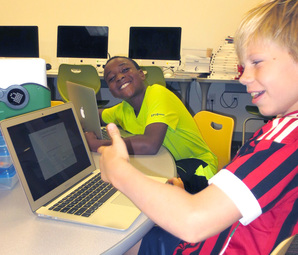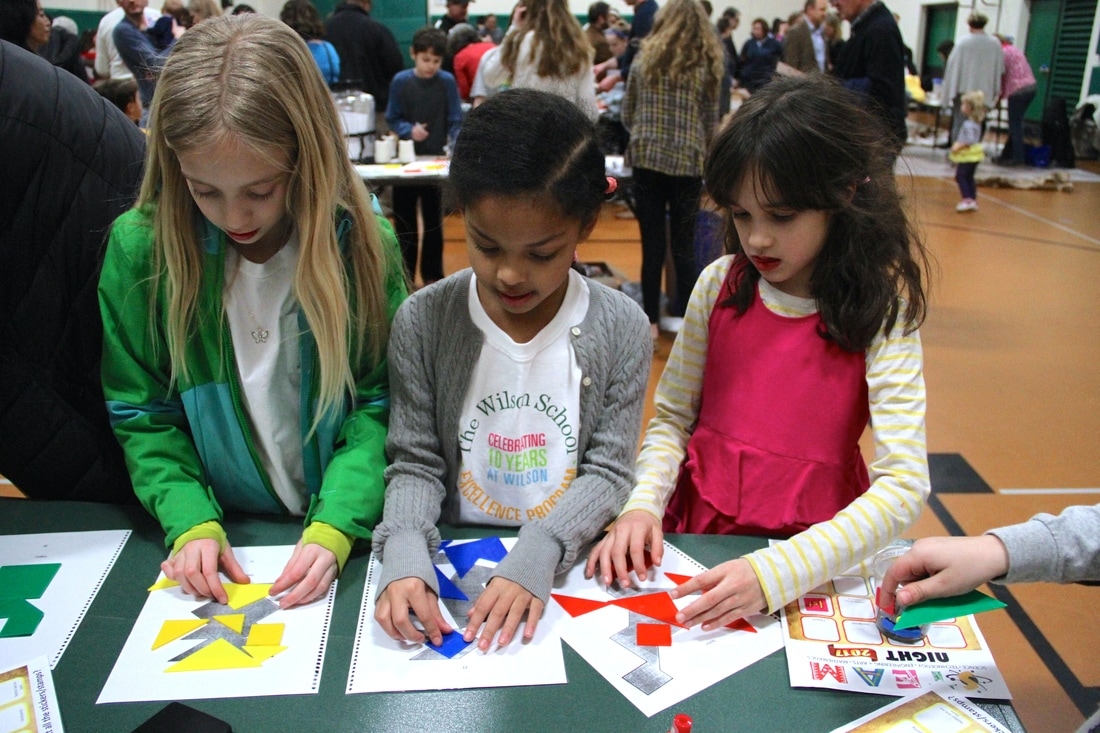|
On Friday, February 11, The Wilson School held its first annual STEAM (science, technology, engineering, art and math) Night - The Art of Science.
The Wilson School families participated in science and art activities, including Wilson’s first ever Time Capsule. Students came with a Time Capsule worksheet, which included a profile and a record of life in 2017. The Time Capsule will be opened in eight years, when current pre-kindergarten students will be in sixth grade. Senior Kindergarten hosted favorite science experiments including alka rockets, moon base building, telescope viewing and space helmet designs. Wilson parent Phil Skemer hosted an earthquake simulation, and other visitors included Bloxels Video Game Design and robotics hosted by the Webster Groves High School and DeSmet Jesuit High School teams. Art projects included popsicle stick harmonicas and marble shake painting. Students created personal handprints to support this year’s Youth Uplift Challenge. With each handprint, the Youth Uplift Challenge will contribute $1.90 for the efforts. The funds support programming in Indonesia and Nicaragua. This year’s visiting artist, Central Print demonstrated printmaking on a press, discussed letterpress and its history and facilitated a printmaking activity for Wilson families. Science specialist Mr. Taylor hopes that The Art of Science event inspired students to become involved in science and to explore new ideas. He looks forward to Wilson students investigating new topics for this year’s science fair.
0 Comments
 The Wilson School provides technology resources to enrich the academic experience of students, faculty and staff. Our new Portable Language Learning Lab and 1-to-1 laptop initiative for children in fourth through sixth grades, are a natural extension of our culture of innovation with an emphasis on authentic learning experiences. The 1-to-1 Initiative Thanks to the generous support of our community, Wilson has the unique advantage at an elementary level to provide one laptop for each student in fourth through sixth grades. This device remains with the student for his or her full three years of the upper school experience. Though the devices do not go home at night, students learn how to responsibly care for and use their “own” technology. “It is important to send our students off to secondary school with the skills they need to navigate their growing independence, and how they use technology is a big part of that,” says Melika Panneri, Technology Coordinator. “Our program covers everything from receiving assignments online, to collaborating with a team to produce a project, to turning the assignment in and everything in between. Our students not only learn what tools to use for what assignment, they learn what it means to be a good digital citizen.” The 1-to-1 program also saves important time in the classroom. With an available laptop always at hand, Wilson offers greater opportunities for students to increase their knowledge, expand their thinking, foster creativity and enhance their communication skills. Portable Language Learning Lab French language acquisition is on an exciting trajectory at Wilson. Our foreign language room is now equipped with a Portable Language Learning Lab, complete with dedicated iPads, which are currently enabled with the Duolingo for Schools program. Traditional classroom and small group lessons are supplemented with individual time in the “lab,” where engaging interactive exercises are customized to each student’s capabilities. Students converse directly with the program to gain comfort in speaking and practicing the language, in addition to building comprehension. As Wilson’s foreign language program grows, so too can the capabilities of the iPads. With the capacity to add, remove or update with new software, we can ensure students are receiving the best offerings available. The Portable Language Learning Lab was made possible by funds raised at the 33rd Annual Thistle Auction in January, 2016.
Sixth grade students recently completed an exciting STEAM project in science combining research, storytelling and moving making.
Each student researched an element, then used the science behind the element's chemical and physical properties to create a superhero. Sixth graders gave their superhero a backstory about how they got their powers and appearance. After creating a 2-D or 3-D figure and writing a script and story board, science teacher Angie Zinkl and technology coordinator Melika Panneri helped the students create a movie using WeVideo. Watch the video below to meet the world's newest superhero, Nitro Girl.
Wilson students have many unique opportunities to stretch their imaginations and explore their creativity. Check out this video about Think Camp, an exciting summer program for current students.
|
PublicationsWilson in the NewsNews Categories
All
|





 RSS Feed
RSS Feed
